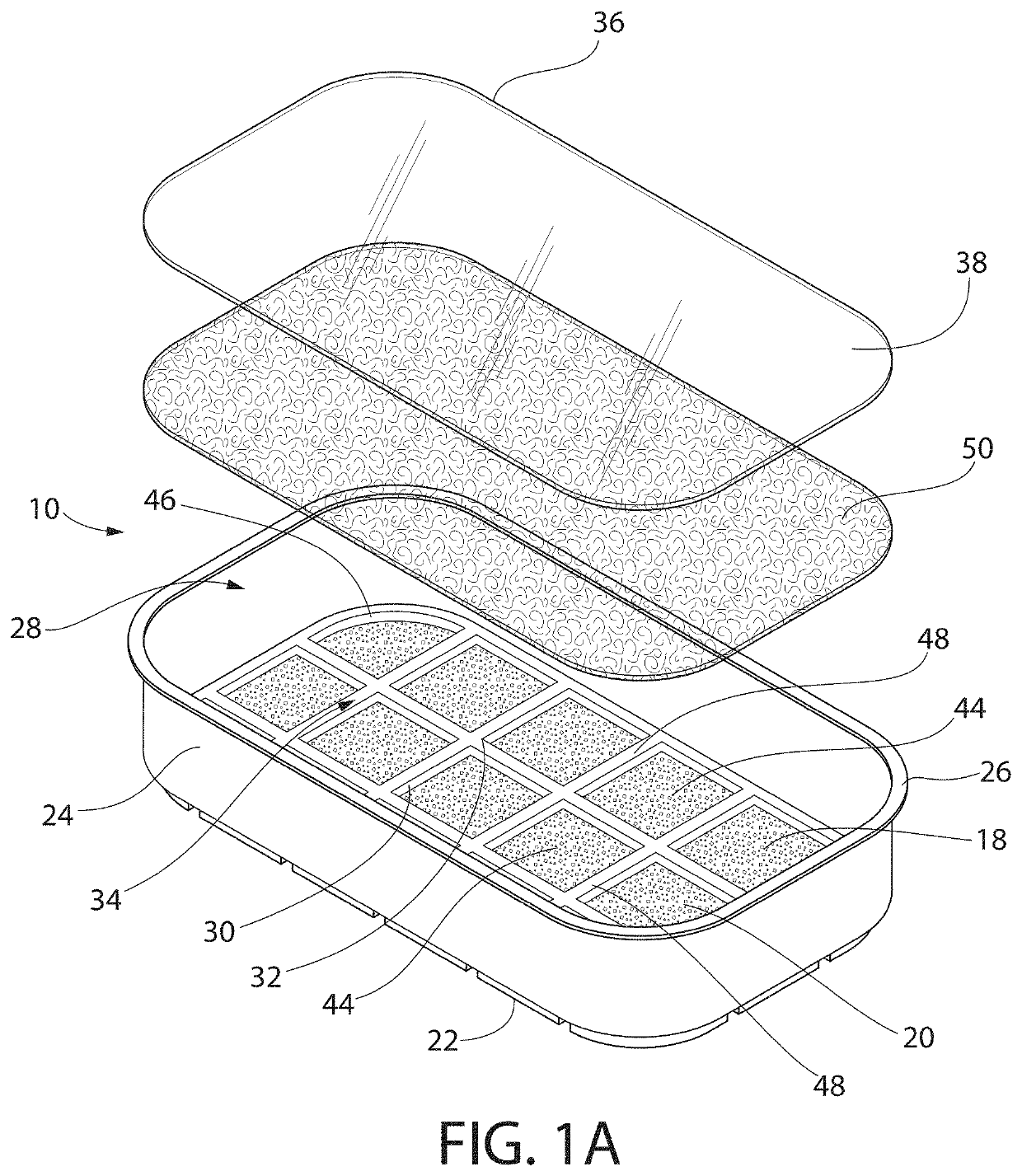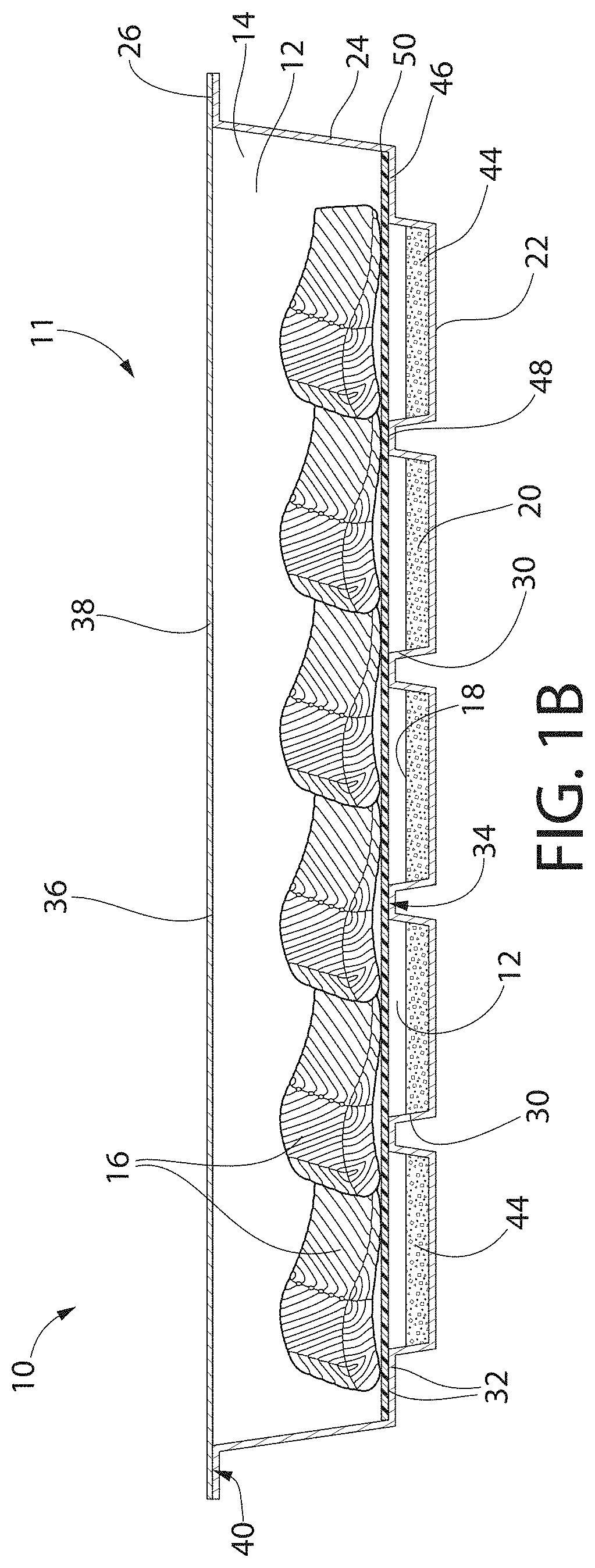Methods of packaging and preserving finfish
a technology of packaging and finfish, applied in the field of methods for packaging and preserving finfish, can solve the problems of short shelf life, food to quickly degrade, seafood is often discolored, unpleasant odor,
- Summary
- Abstract
- Description
- Claims
- Application Information
AI Technical Summary
Benefits of technology
Problems solved by technology
Method used
Image
Examples
example 1
east and Mold in Cod
[0119]On day 0, cod fillets were received from a fishery. The cod fillets were stored in a Styrofoam cooler with flake ice or gel packs during shipment. Four to five pounds of cod fillets were taken out and stored in a storage container (approximately 12.5″×10.5″×2″) generally similar to that shown in FIG. 1, with a lidding film sealed thereon to enclose the fillets. The sealed container was placed into a cooler at 4° C. Ten pounds of cod fillets were placed in a plastic control tray (15.7″×11.5″×2.7″) with a snap on plastic lid also stored in refrigerated conditions.
[0120]Three 25 g samples on each of days 0, 11 and 13 were taken. Lactic acid bacteria counts were measured, denoted in units of colony forming units per gram, or CFU / g. The following table shows the data, wherein “MCT Tray” refers to the sealed storage container described above. The data below is plotted in a corresponding graph in FIG. 8.
TABLE 2Lactic Acid Bacteria GrowthCOUNTSLOGDayDayDayDayDayDay...
example 2
n Score of Cod
[0123]On days 11 and 13, the cod fillets stored as described in Example 1 from a sealed storage container and the corresponding control tray were sampled for overall sensory perception in appearance on the hedonic scale.
TABLE 4Sensory - AppearanceDayCONTROLMCT TRAY05.05.0111.03.0131.03.0
[0124]FIG. 10 shows the appearance of the samples after 13 days. The original photographs are in color. The coloration may not be easily discernible since the photographs are presented in black and white (due to patent filing constraints). Even though the photographs are in black and white, it is clear that the cod stored in the MCT tray (right) is far less discolored and harbors fewer microbes as evidenced by the streaks of shiny growth compared to the cod stored in the control tray (left).
[0125]The sensory perception score and the microbial growth counts convincingly demonstrate that the fresh cod fillets stored in the MCT tray are better preserved after 11 to 13 days compared to thos...
example 3
east and Mold in Flounder
[0126]On day 0, flounder fillets were received from a fishery. The flounder fillets were stored in a Styrofoam cooler with flake ice or gel packs during shipment. Four to five pounds of flounder fillets were taken out and stored in a storage container (approximately 12.5″×10.5″×2″) generally similar to that shown in FIG. 1, with a lidding film sealed thereon to enclose the fillets. The sealed container was placed into a cooler at 4° C. Ten pounds of flounder fillets were placed in a plastic control tray (15.7″×11.5″×2.7″) with a snap on plastic lid also stored in refrigerated conditions.
[0127]Three 25 g samples on each of days 0, 11 and 15 were taken. Aerobic bacteria and lactic acid bacteria counts were measured, denoted in units of colony forming units per gram, or CFU / g. Tables 5 and 6 below show the data, wherein “MCT Tray” refers to the sealed storage container described above. The data below are plotted in the corresponding graphs in FIGS. 11 and 12.
TA...
PUM
 Login to View More
Login to View More Abstract
Description
Claims
Application Information
 Login to View More
Login to View More - R&D
- Intellectual Property
- Life Sciences
- Materials
- Tech Scout
- Unparalleled Data Quality
- Higher Quality Content
- 60% Fewer Hallucinations
Browse by: Latest US Patents, China's latest patents, Technical Efficacy Thesaurus, Application Domain, Technology Topic, Popular Technical Reports.
© 2025 PatSnap. All rights reserved.Legal|Privacy policy|Modern Slavery Act Transparency Statement|Sitemap|About US| Contact US: help@patsnap.com



